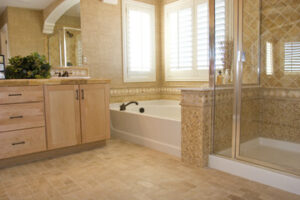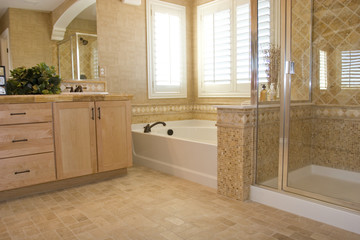A remodel can save money on a water heater, reduce the amount of electricity used to run appliances and fixtures, and even improve your home’s energy efficiency. Researching materials, comparing prices at basic home improvement stores, specialty shops, and online markets, and planning ahead can help with budgeting for the project.
No matter what type of remodeling you plan, there are always unforeseen expenses that may increase the cost. That is why it is important to have a budget and stick to it. Also, remember that the cost of materials will vary from location to location. This can add a few thousand dollars to your overall project. If you need some help from the experts, contact J&R Construction now!
When making a budget, you will need to consider what features are absolutely necessary for your bathroom. For example, adding a walk-in tub or replacing your existing one will be more expensive than simply installing a new shower. Other features to consider include lighting, ventilation, and storage space. It is also a good idea to think about who will be using the bathroom and what their needs are. For instance, if you have children, you will want to make sure there is adequate storage and space for bath toys. If you have family members with reduced mobility, you will want to ensure the bathroom is ADA-accessible.
Finally, don’t forget that you will likely need to get a permit for your bathroom remodel. This is especially true for any significant changes that require demolition and/or new plumbing lines. Obtaining a permit is often a complicated process and can add to your overall project costs. It is important to choose a reputable contractor with experience working on bathroom projects who can help you navigate the permitting process.
Don’t overcomplicate things.
It’s easy to get overwhelmed when planning a bathroom remodeling project. There’s just so much to consider: paint colors, tile styles and textures, fixtures, layout, storage, and accessories, just to name a few.
One of the most common mistakes homeowners make is trying to do too much in a remodel. This often leads to a rushed job that ends up costing more in the long run.
When it comes to bathroom remodeling, a little bit of planning can go a long way toward keeping costs down and ensuring that the project is done right the first time. So take your time when planning a remodel, and don’t be afraid to ask for help from a professional if you need it.
An experienced contractor will know exactly what it takes to make your vision a reality and avoid costly mistakes along the way. They can do exploratory work to sniff out any issues before they become a problem, such as investigating the vent stack above your bathroom to see what it’s made of and to figure out how to access it when you need to change a fixture. They can also plan ahead and ensure that all the work is completed in a logical order so that the bathroom can be used again as soon as possible. This will keep the project running smoothly and avoid workflow-disrupting delays.
Start at the top.
There are a lot of ways to increase the value of your bathroom. You can add a new paint job and install modern fixtures that give it a sleek look. This type of upgrade reflects positively on your home’s overall value and could even boost your credit score.
You can also improve your bathroom’s functionality by incorporating design features that are friendly to people with disabilities. These types of upgrades are referred to as “universal design” and are becoming increasingly popular. They can help people with different physical abilities enjoy the benefits of a fully functional bathroom, regardless of their age.
The other big way to add value is to make structural changes. This level of remodeling goes far beyond simply changing the fixtures and can involve major layout changes that alter the footprint of the room. This can be quite cumbersome and expensive, but it can be done if you’re willing to work with a contractor that can handle the complexities of such a project.
The decision of whether to remodel or renovate your bathroom can be a personal one based on your financial situation and goals for the future. It has to be made from a realistic perspective, however. You should always keep in mind that your home is an investment, and it needs to be properly cared for in order to maximize its potential.
Do a “full gut.”
Bathrooms are one of the most-used rooms in a home, and the right remodel can transform them from a utilitarian space into a spa-like oasis. In addition, updating a bathroom can help increase your home’s value and make it easier to sell.
However, the cost of a bathroom remodel can be prohibitive for some homeowners. Fortunately, there are many ways to save money on your remodel without sacrificing quality or style. You can choose cheaper materials, do the work yourself, or shop around for contractors. Choosing a contractor with experience in bathroom remodeling will also ensure that the project is done correctly and won’t require costly corrections later on.
The size of the bathroom is another major factor in determining the cost of the remodel. Large bathrooms will generally cost more to remodel than smaller bathrooms, and adding features like walk-in showers or dual sinks can significantly increase the price tag.
Depending on the scope of your remodel, it may be possible to keep some existing elements. For example, if your bathroom door matches the other doors in your home, it may be less expensive to reuse it than to replace it completely. However, if your bathroom is in need of an entirely new window, a replacement can offer increased energy efficiency and provide a more modern look to the room.
A mid-range bathroom remodel can usually be completed for $75,000 to $100,000. This type of remodel is an ideal option for homeowners who want to update their bathrooms with new materials but don’t need a complete overhaul. This type of remodel will typically include a new tub-shower combo, sink with vanity, toilet, premium Caesar Stone quartz countertops, pre-finished cabinets and hardware, premium paint, and applied design techniques to create a more spacious feeling.
Plan for adequate lighting.
A properly planned lighting arrangement can make a huge difference in the overall look and feel of a bathroom. It can transform a room from one that’s just functional to a true oasis for relaxation.
When planning your bathroom lighting, consider incorporating a mix of task and ambient lighting. Task lighting is ideal for areas like the vanity, where you’ll be applying makeup or shaving, while ambient lighting can help create a relaxing atmosphere. You can also use accent lights to add some drama or highlight a specific decorative element.
Another important consideration is to ensure that your bathroom has enough outlets for all of the electrical devices you’ll be using there. This includes things like hair dryers and electric toothbrushes.
Finally, don’t forget about the importance of lighting fixtures that can withstand moisture and humidity. Many fixture, switch, and bulb upgrades can be done on your own, but you should always hire a qualified electrician to perform any wiring or work that needs to be completed to code.
Another great way to save money is to upgrade your bulbs to LEDs. These bulbs use significantly less energy than traditional bulbs, and they have a much longer lifespan. This will reduce your utility bill and save you from having to replace your bulbs frequently. This will also help reduce your carbon footprint and contribute to a greener home.
Plan for new accessories.
No bathroom remodel is complete without a few new accessories. From towels, wash clothes, and soap dishes to mirrors and towel racks, all can enhance the function and style of your newly remodeled space. When choosing your accessories, take the time to consider size, material, and color options so they coordinate with the rest of your décor.
It’s important to think about all the items that will be included in your bathroom and plan for their installation early on in your project. This helps ensure that all the pieces work together seamlessly and avoids costly rework or additional construction to get the look you’re hoping for.
For example, it is often best to install the vanity before installing the bathtub or shower. Similarly, it is typically best to install the flooring before the walls.
This not only allows for proper installation but also minimizes any dust and debris that could impact the finished product.
It’s also a good idea to plan for a variety of fixture innovations as you shop, such as anti-scald guards and digital displays that indicate the temperature of water. Additionally, it is a good idea to plan ahead for the possibility of future accessibility needs by including blocking between wall studs for grab bars or other support fixtures. This is especially true in bathrooms with showers and tubs that are 33 to 36 inches high from the floor.
